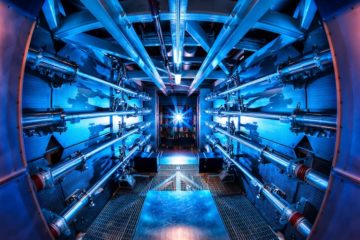Shannon Osaka in The Washington Post:
 Existing nuclear power plants work through fission — splitting apart heavy atoms to create energy. In fission, a neutron collides with a heavy uranium atom, splitting it into lighter atoms and releasing a lot of heat and energy at the same time. Fusion, on the other hand, works in the opposite way — it involves smushing two atoms (often two hydrogen atoms) together to create a new element (often helium), in the same way that stars creates energy. In that process, the two hydrogen atoms lose a small amount of mass, which is converted to energy according to Einstein’s famous equation, E=mc². Because the speed of light is very, very fast — 300,000,000 meters per second — even a tiny amount of mass lost can result in a ton of energy.
Existing nuclear power plants work through fission — splitting apart heavy atoms to create energy. In fission, a neutron collides with a heavy uranium atom, splitting it into lighter atoms and releasing a lot of heat and energy at the same time. Fusion, on the other hand, works in the opposite way — it involves smushing two atoms (often two hydrogen atoms) together to create a new element (often helium), in the same way that stars creates energy. In that process, the two hydrogen atoms lose a small amount of mass, which is converted to energy according to Einstein’s famous equation, E=mc². Because the speed of light is very, very fast — 300,000,000 meters per second — even a tiny amount of mass lost can result in a ton of energy.
